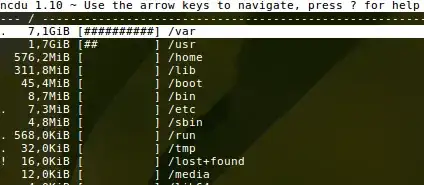How can I get the current disk usage (in %) of my hard drive from the command line?
Asked
Active
Viewed 3.2e+01k times
200
2 Answers
209
ncdu
Works well from the command line. It's ncurses-based and interactive.
You can install it with sudo apt-get install ncdu.
Alternatives
- Top ten:
du -shx * | sort -rh | head -10 - If you want more fine grained disk usage, you should take a look at the answers here.
N0rbert
- 99,918
Ehtesh Choudhury
- 5,591
-
3
-
1I liked the alternatives. You have to be in the directory you are looking for the large files. But I found it easy to spot the culprit this way without having to install anything. – G Trawo Sep 18 '18 at 14:49
-
3
du -shx * | sort -rh | head -10is a lifesaver! Especially great if you are on a small test server, you have run out of space, and do not already have a fancy utility installed to fix your problems. – Michael Plautz Oct 04 '18 at 18:52 -
-
The Top ten item above is very helpful, however, it omits hidden directories. Is there an easy way to include them? – dvhirst Jan 05 '21 at 05:57
-
Oh my god I almost died here! While in this tool, be VERY CAREFUL not to think you're on the command line and do
cd folderbecause D is DELETE and space will CONFIRM :O – Jerther Nov 03 '23 at 16:38
186
By using the df command.
Here's an example output:
$ df
Filesystem 1K-blocks Used Available Use% Mounted on
/dev/sda1 303537496 27537816 260580948 10% /
none 950788 252 950536 1% /dev
none 959516 232 959284 1% /dev/shm
none 959516 388 959128 1% /var/run
none 959516 0 959516 0% /var/lock
Also take a look at its manpage.
htorque
- 64,798
-
51
df -mwill show things in megabytes,df -hwill show you in the largest possible unit. – Oli Jan 11 '11 at 15:48

kdirstatorbaobab. – Ehtesh Choudhury Jun 06 '13 at 23:15